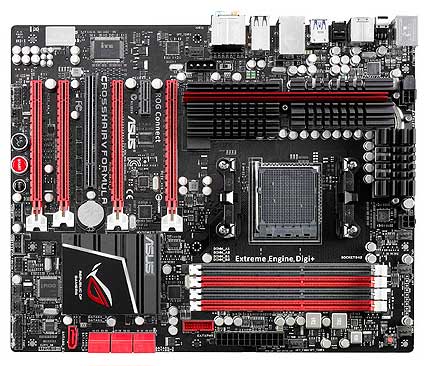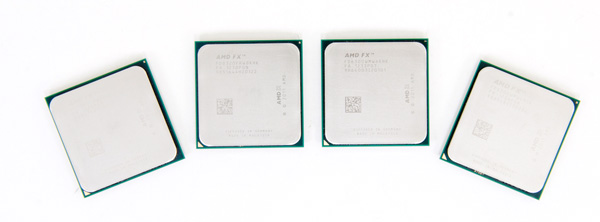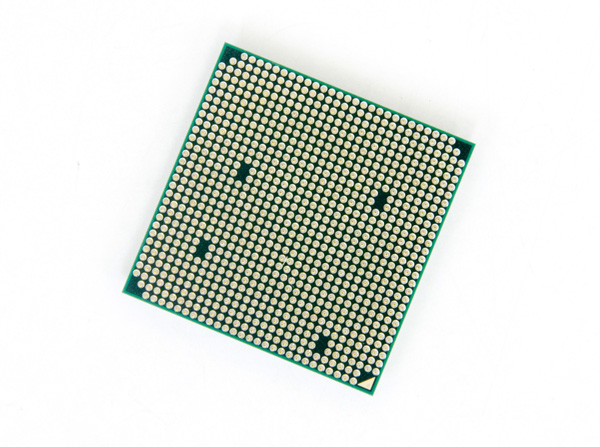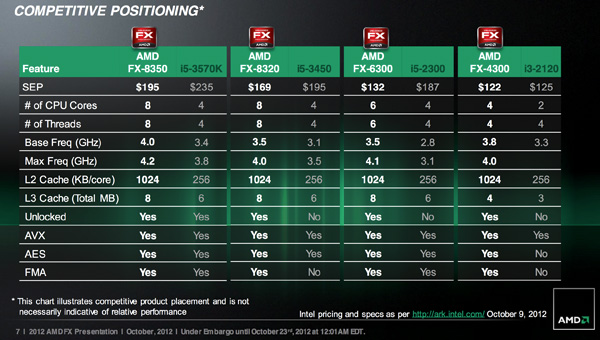The Vishera Review: AMD FX-8350, FX-8320, FX-6300 and FX-4300 Tested
by Anand Lal Shimpi on October 23, 2012 12:00 AM ESTLast year's launch of AMD's FX processors was honestly disappointing. The Bulldozer CPU cores that were bundled into each Zambezi chip were hardly power efficient and in many areas couldn't significantly outperform AMD's previous generation platform. Look beyond the direct AMD comparison and the situation looked even worse. In our conclusion to last year's FX-8150 review I wrote the following:
"Single threaded performance is my biggest concern, and compared to Sandy Bridge there's a good 40-50% advantage the i5 2500K enjoys over the FX-8150. My hope is that future derivatives of the FX processor (perhaps based on Piledriver) will boast much more aggressive Turbo Core frequencies, which would do wonders at eating into that advantage."
The performance advantage that Intel enjoyed at the time was beyond what could be erased by a single generation. To make matters worse, before AMD could rev Bulldozer, Intel already began shipping Ivy Bridge - a part that not only increased performance but decreased power consumption as well. It's been a rough road for AMD over these past few years, but you have to give credit where it's due: we haven't seen AMD executing this consistently in quite a while. As promised we've now had multiple generations of each platform ship from AMD. Brazos had a mild update, Llano paved the way for Trinity which is now shipping, and around a year after Zambezi's launch we have Vishera: the Piledriver based AMD FX successor.
At a high level, Vishera swaps out the Bulldozer cores from Zambezi and replaces them with Piledriver. This is the same CPU core that is used in Trinity, but it's optimized for a very different purpose here in Vishera. While Trinity had to worry about working nicely in a laptop, Vishera is strictly a high-end desktop/workstation part. There's no on-die graphics for starters. Clock speeds and TDPs are also up compared to Trinity.
| CPU Specification Comparison | ||||||||
| CPU | Manufacturing Process | Cores | Transistor Count | Die Size | ||||
| AMD Vishera 8C | 32nm | 8 | 1.2B | 315mm2 | ||||
| AMD Zambezi 8C | 32nm | 8 | 1.2B | 315mm2 | ||||
| Intel Ivy Bridge 4C | 22nm | 4 | 1.4B | 160mm2 | ||||
| Intel Sandy Bridge E (6C) | 32nm | 6 | 2.27B | 435mm2 | ||||
| Intel Sandy Bridge E (4C) | 32nm | 4 | 1.27B | 294mm2 | ||||
| Intel Sandy Bridge 4C | 32nm | 4 | 1.16B | 216mm2 | ||||
| Intel Lynnfield 4C | 45nm | 4 | 774M | 296mm2 | ||||
| Intel Sandy Bridge 2C (GT1) | 32nm | 2 | 504M | 131mm2 | ||||
| Intel Sandy Bridge 2C (GT2) | 32nm | 2 | 624M | 149mm2 | ||||
Vishera is still built on the same 32nm GlobalFoundries SOI process as Zambezi, which means there isn't much room for additional architectural complexity without ballooning die area, and not a whole lot of hope for significantly decreasing power consumption. As a fabless semiconductor manufacturer, AMD is now at GF's mercy when it comes to moving process technology forward. It simply has to make 32nm work for now. Piledriver is a light evolution over Bulldozer, so there's actually no substantial increase in die area compared to the previous generation. Cache sizes remain the same as well, which keeps everything roughly the same. These chips are obviously much larger than Intel's 22nm Ivy Bridge parts, but Intel has a full node advantage there which enables that.
Piledriver is a bit more power efficient than Bulldozer, which enables AMD to drive Vishera's frequency up while remaining in the same thermal envelope as Zambezi. The new lineup is in the table below:
| CPU Specification Comparison | ||||||||||
| Processor | Codename | Cores | Clock Speed | Max Turbo | L2/L3 Cache | TDP | Price | |||
| AMD FX-8350 | Vishera | 8 | 4.0GHz | 4.2GHz | 8MB/8MB | 125W | $199 | |||
| AMD FX-8150 | Zambezi | 8 | 3.6GHz | 4.2GHz | 8MB/8MB | 125W | $183 | |||
| AMD FX-8320 | Vishera | 8 | 3.5GHz | 4.0GHz | 8MB/8MB | 125W | $169 | |||
| AMD FX-8120 | Zambezi | 8 | 3.1GHz | 4.0GHz | 8MB/8MB | 125W | $153 | |||
| AMD FX-6300 | Vishera | 6 | 3.5GHz | 4.1GHz | 6MB/8MB | 95W | $132 | |||
| AMD FX-6100 | Zambezi | 6 | 3.3GHz | 3.9GHz | 6MB/8MB | 95W | $112 | |||
| AMD FX-4300 | Vishera | 4 | 3.8GHz | 4.0GHz | 4MB/4MB | 95W | $122 | |||
| AMD FX-4100 | Zambezi | 4 | 3.6GHz | 3.8GHz | 4MB/4MB | 95W | $101 | |||
The table above says it all. TDPs haven't changed, cache sizes haven't changed and neither have core counts. Across the board Vishera ships at higher base frequencies than the equivalent Zambezi part, but without increasing max turbo frequency (in the case of the 8-core parts). The 6 and 4 core versions get boosts to both sides, without increasing TDP. In our Trinity notebook review I called the new CPU core Bulldozed Tuned. The table above supports that characterization.
It's also important to note that AMD's pricing this time around is far more sensible. While the FX-8150 debuted at $245, the 8350 drops that price to $199 putting it around $40 less than the Core i5 3570K. The chart below shows where AMD expects all of these CPUs to do battle:
AMD's targets are similar to what they were last time: Intel's Core i5 and below. All of the FX processors remain unlocked and ship fully featured with hardware AES acceleration enabled. Most Socket-AM3+ motherboards on the market today should support the new parts with nothing more than a BIOS update. In fact, I used the same ASUS Crosshair V Formula motherboard I used last year (with a much newer BIOS) for today's review:

The Test
For more comparisons be sure to check out our performance database: Bench.
| Motherboard: | ASUS Maximus V Gene (Intel Z77) ASUS Crosshair V Formula (AMD 990FX) |
| Hard Disk: | Intel X25-M SSD (80GB) Crucial RealSSD C300 OCZ Agility 3 (240GB) Samsung SSD 830 (512GB) |
| Memory: | 4 x 4GB G.Skill Ripjaws X DDR3-1600 9-9-9-20 |
| Video Card: | ATI Radeon HD 5870 (Windows 7) NVIDIA GeForce GTX 680 (Windows 8) |
| Desktop Resolution: | 1920 x 1200 |
| OS: | Windows 7 x64/Windows 8 Pro x64 |













250 Comments
View All Comments
coder111 - Tuesday, October 23, 2012 - link
Now what I'd like to see is how many of these benchmarks are compiled with intel compiler. In case you don't know yet, Intel Compiler disables a lot of optimizations if you are not running a Genuine Intel CPU, even if your CPU supports required features and would benefit from these optimizations. In other words, anything compiled with intel compiler will run slower on AMD cpus just because of Intel compiler.Now you can argue that this is a reflection of real performance on Windows, as in Windows quite a few of DLLs are compiled with Intel Compiler as well.
What I'd like to see is some more benchmarks for Linux operating system and/or professional software. Things like data base servers (including something non-Microsoft, like PostgreSQL or MySQL), java application servers, GCC compiler benchmarks, apache/PHP server, virtualization, python/perl/ruby, LibreOffice/OpenOffice productivity.
Now, back to Vishera. This looks like a nice CPU. I haven't been CPU bound in my work for a while now, so performance wise this would be sufficient for my needs. What I'd like to see however is lower power consumption. Unfortunatelly I don't see that coming until Global Foundries minimizes their process...
CeriseCogburn - Tuesday, October 30, 2012 - link
So amd has abandoned gamers on the cpu side.Good to know.
Blibbax - Tuesday, October 23, 2012 - link
The dragon age origins graph has the 8150 in blue and no i3.Blibbax - Tuesday, October 23, 2012 - link
SC2 and WoW also.dishayu - Tuesday, October 23, 2012 - link
7zip as wellBlibbax - Tuesday, October 23, 2012 - link
"As I mentioned earlier however, this particular test runs quicker on Vishera however the test would have to be much longer in order to really give AMD the overall efficiency advantage. "If you think about it, efficiency is unrelated to length of test.
CeriseCogburn - Tuesday, October 30, 2012 - link
He was talking about electrical usage vs work done, hence with amd's higher per second use of electricity, it must complete the test MUCH faster than Intel in order to win that.It completed faster, but not fast enough to use less power.
This lesson is over for amd.
iTzSnypah - Tuesday, October 23, 2012 - link
In price per performance. A 125w part beating a 67w (Not sure about that figure) will cause Intel to keep the same TDW for 2014 and just have a 35-40% performance increase. I can only hope.CeriseCogburn - Tuesday, October 30, 2012 - link
If you're used to running or servicing Intel cpu's then you pick up the LEAD WEIGHT that is the modern AMD cpu, all that HEAT SINKING comes to mind.I mean they are just honkers. You pick it up and it's like what the heck !?
meloz - Tuesday, October 23, 2012 - link
I wish Anandtech would include some form of value scatter graphs like Techreport does in its reviews. The graphs do not have to be an exact imitation of what Techreport does, and the benchmark(s) used to determine the 'overall performance' can be different. Perhas we could even get performance per watt per dollar graphs.Graphs like these make the whole exercise of comparing competing products so much more relevant to users, because most of us will buy the most performant processor per dollar.
As example:
http://techreport.com/r.x/amd-fx-8350/value-scatte...
http://techreport.com/r.x/amd-fx-8350/gaming-scatt...
This is, of course, considering the result without any attention to performance/watt. If you include power consumption in the calculations at all, Intel is an easy choice.
Difficult to see how AMD will cope with Haswell, even if they get another 15% boost next year. The gap in performance / watt only seems to be diverging, Intel taking a commanding lead.